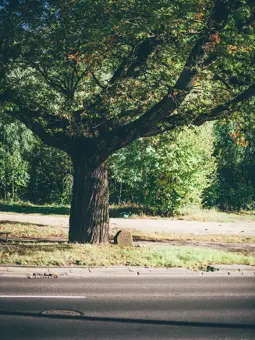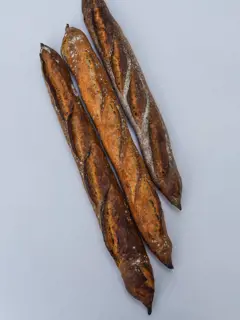
Jaśkowa Dolina is easy to reach, because it is one of the extensions of Aleja Grunwaldzka, Gdańsk’s main artery. While walking down Jaśkowa (that’s how locals refer to it) in the direction of Grunwaldzka, all you should do is admire the architecture. Let’s begin with the abandoned villa at no. 23 – it’s hidden behind a willow that bends over a stream. I love this building with all its details: from stone balls adorning the entrance to low-relief wall sculptures and richly ornamented balustrades.
My two other favorites come next: a red-brick villa and a tenement house with metal ornaments, now a home to an architecture studio. Rusty rosettes, like earrings, give the building a special flair. Beautiful half-timbered houses stand right next to it, surrounded by lush greenery. I like seeing my way through this green thicket to look at a veranda with its ornamental door, stone balls and whimsically shaped balustrades decorating side entrances. Back in the day, the houses, located close to the city but next to the forest, must have been a true haven for their owners. Now, with a busy and noisy street as their neighbor, they must be missing the good old days.






On the other side of the street, you can see a lone oak tree with a stone plaque. I used to come up with all kinds of romantic stories on seeing such sights, thinking of the plaque as the gravestone etc., but, in this case, the truth has turned out to be quite prosaic. The plaque states that the tree was planted in 1863 by students from one of Gdańsk’s middle schools willing to commemorate the Polish victory in the Battle of Leipzig. Nice to know, isn’t it?
Now, let’s take Pawłowskiego street, a cobblestone extension of Jaśkowa Dolina. This is one of my favorite streets; each of the buildings here deserves attention and so do old metal gates which look as if they all led to some secret gardens. I also love walls covered with ivy and steps leading to the forest.
We are only a few blocks away from the greatest treasure of Jaśkowa Dolina – and, in my opinion, the whole Tricity – the former Forsthaus restaurant. It seems like I’ve been overusing the word „beautiful” lately, but – believe me – I’ve been in love with this neighborhood for over a decade and my feelings haven’t lost a bit of their strength. The Forsthaus Villa (1) is one of the two buildings in the city I love the most (join me on my future walks to see the other one). Its wooden structure makes it more fit for the mountains rather than the seaside, but perhaps that’s what makes it special. Filled with awe, I keep staring. Tiny bells on the balcony harmonize with the wind, creating an extraordinary atmosphere. A wooden shrine hangs on a tree vis-a-vis the villa; it’s worth looking at. Rumor has it there used to be tennis courts somewhere nearby and that Prince Wilhelm, a successor to the Prussian throne, used to go tobogganing in the neighborhood. Did you know?





Let’s leave Pawłowskiego and go back to Jaśkowa Dolina. Next to a bus stop, we’re passing a house steeped in zinnias, a neighbor to Jaśkowy Zakątek (2) – a rose garden with a romantic arbor, stone benches, a fountain and a statue of Fortuna. The place is new, but its layout resembles that of a park that used to be here before the war.
Our walk is slowly coming to an end. I recommend that you take a side street and find your way back home through the forest, giving yourself a chance to admire the green side of Jaśkowa Dolina. If you happen to have a thermos with tea and some cookies or sandwiches with you, go and have yourself a little picnic in Teatr Leśny (3) located a bit deeper in the woods. Everything tastes better on wooden furniture scattered among rustling trees, doesn’t it? Keep Teatr Leśny in mind – concerts are organized here in summer.
Those of you without any food should definitely visit Aioli (4) – a restaurant in a red-brick tenement house serving delicious breakfasts and lunches. I really like this place, both for its visual and culinary aspects. The interior was designed to accentuate the original elements – red brick works well with industrial touches. I particularly enjoy their lemonades, a glass of Prosecco with lavender and blueberries (no kidding!) in the afternoon, delicious seafood in crispy coating, and thick-cut French fries with aioli sauce. It’s a kids-friendly space, with an indoor playground and occasional special activities.
On your way to Aioli, visit a beautiful florist’s – Mały Park (5). I used to admire it every day from the bus window, but today it’s my destination. Right next to it there is a confectionery – NOTOCIACHo (6) – selling homemade sweets. Every lover of authentic food will appreciate their butter buns and delicious cakes.
I’ve almost forgotten: if you visit Jaśkowa Dolina in autumn, remember about chestnuts! This street used to be one grand chestnut valley and quite a few of these trees are still here. Chestnut hunters armed with tote bags always come here in September. Now it’s your turn to hunt some autumnal treasure!





Locations:
1. The Forsthaus Villa, ul. Jaśkowa Dolina
2. Jaśkowy Zakątek, ul. Jaśkowa Dolina 67
3. Teatr Leśny, ul. Jaśkowa Dolina 45
4. Aioli, ul. Partyzantów 6, Gdańsk
5. MAŁY PARK, flower shop, ul. Władysława Pniewskiego 3, Gdańsk.
6. NOTOCHIACHo, ul. Władysława Pniewskiego 3A, Gdańsk.
Text and photos:
Ania Włodarczyk - Gdańsk citizen by choice – since 2007 sharing her passion for writing, cooking, and photography on her blog Strawberries from Poland. Her articles about cooking are featured in magazines and on websites. She is a collector of old cookbooks actively engaged in food photography. Her second book – Kuchnia retro – was published this autumn.
Information related to the history of the place and old photographs: www.gedanopedia.pl


Similiar Articles

- Trend
- Art
- People
- News
- Poland
Bielska Jesień – interview with Ada Piekarska, curator of poland's premier painting competition

- Trend
- News
- Poland
Urban Jungle – a children's book published by PURO

- Trend
- News
- Poland
